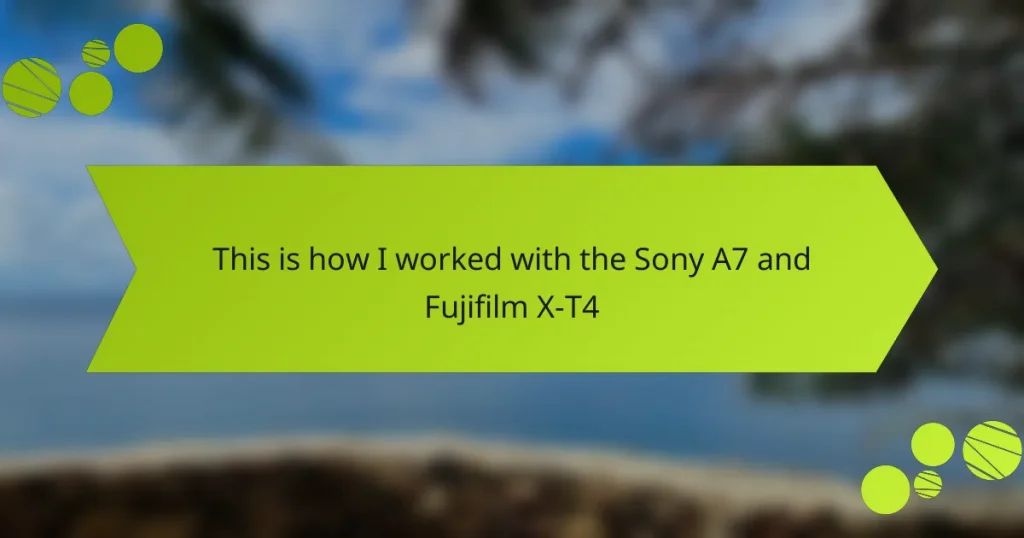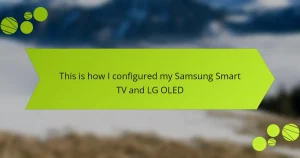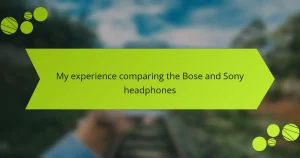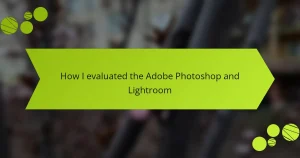Key takeaways
- The Sony A7 excels in low-light photography with its full-frame sensor, while the Fujifilm X-T4 is renowned for vibrant colors and dynamic range, making it ideal for landscape and portrait photography.
- The A7 features a powerful autofocus system and performs well in fast-paced environments, whereas the X-T4’s in-body image stabilization enhances sharpness in low-light conditions.
- Fujifilm’s film simulation modes provide creative flexibility, allowing photographers to achieve various looks without post-processing.
- Choosing between the two cameras depends on shooting style, with the A7 more suitable for low-light scenarios and the X-T4 appealing for color-rich photography and video capabilities.
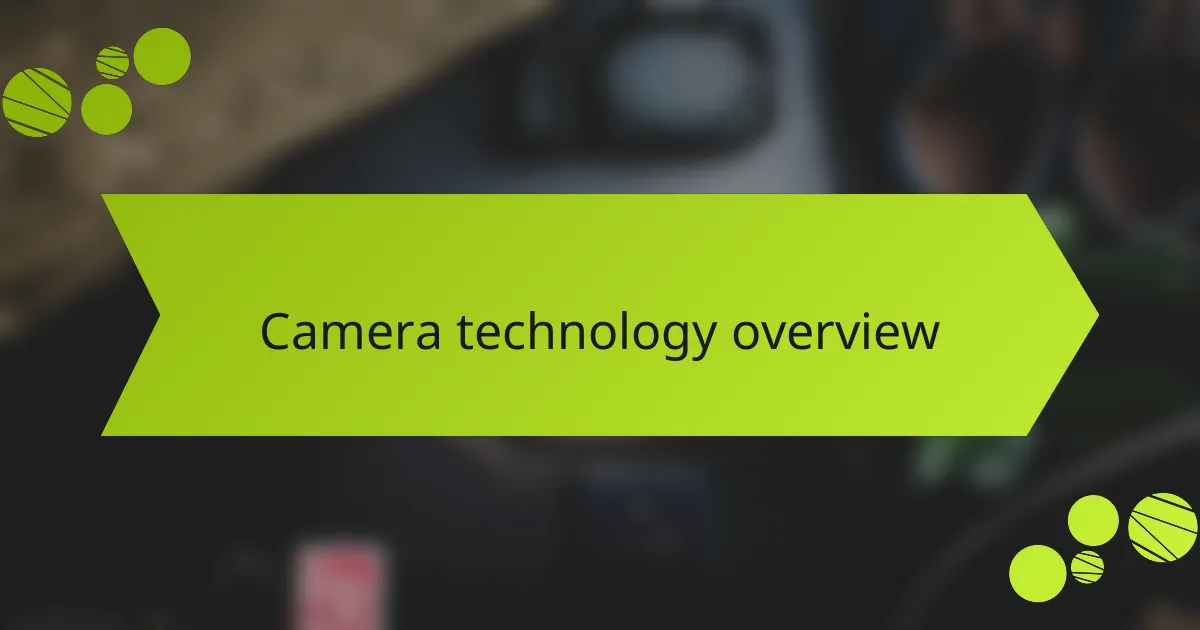
Camera technology overview
When diving into the camera technology of the Sony A7 and Fujifilm X-T4, it’s clear that each offers unique strengths tailored to different types of photographers. The Sony A7, with its full-frame sensor, excels in low-light conditions, allowing for stunning night photography that captures detail beautifully. Meanwhile, the Fujifilm X-T4’s APS-C sensor provides vibrant colors and impressive dynamic range, which I found particularly appealing for landscape photography.
Using the A7 for a recent event, I was amazed at how well it handled the dimly lit environment, while the X-T4 felt like a creative extension of myself during a colorful fall portrait session. Both cameras have innovative features that cater to distinct preferences, which I can’t help but appreciate as a photographer who enjoys alternating styles based on the subject and environment.
| Feature | Sony A7 | Fujifilm X-T4 |
|---|---|---|
| Sensor Type | Full-frame | APS-C |
| ISO Range | 100-51,200 | 160-12,800 |
| Continuous Shooting Speed | 10 fps | 15 fps |
| Video Capabilities | 4K 30p | 4K 60p |
| Weight | 650g | 607g |
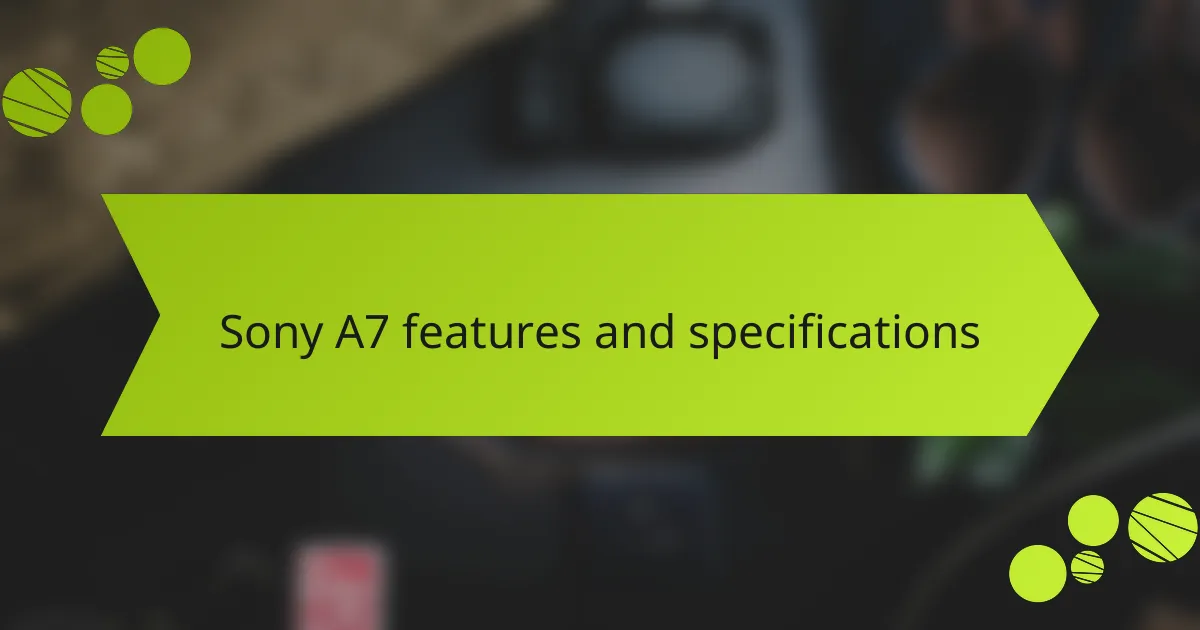
Sony A7 features and specifications
When I first got my hands on the Sony A7, I was genuinely excited by its lightweight design coupled with powerful capabilities. One of the standout features is its full-frame sensor, delivering stunning low-light performance and dynamic range that makes every shot pop. I remember capturing a sunset, and the colors were so vibrant; it felt almost like the scene in front of me was alive on the camera’s display.
The autofocus system also impressed me. With 117 phase-detection points and 25 contrast detection points, it locks onto subjects quickly and accurately. During a recent shoot, I was amazed at how easily it tracked a moving subject, something that has made my photography experience immensely rewarding.
Here’s a quick comparison of the Sony A7’s key features and specifications:
| Feature | Specification |
|---|---|
| Sensor Type | Full-frame 35.9 x 24.0 mm |
| Megapixels | 24.3 MP |
| ISO Range | 100-25600 (expandable to 50-51200) |
| Autofocus Points | 117 phase-detection + 25 contrast detection |
| Continuous Shooting Speed | 5 fps |
| Video Resolution | Full HD 1080p at 60 fps |
| Weight | Body only: 650g |
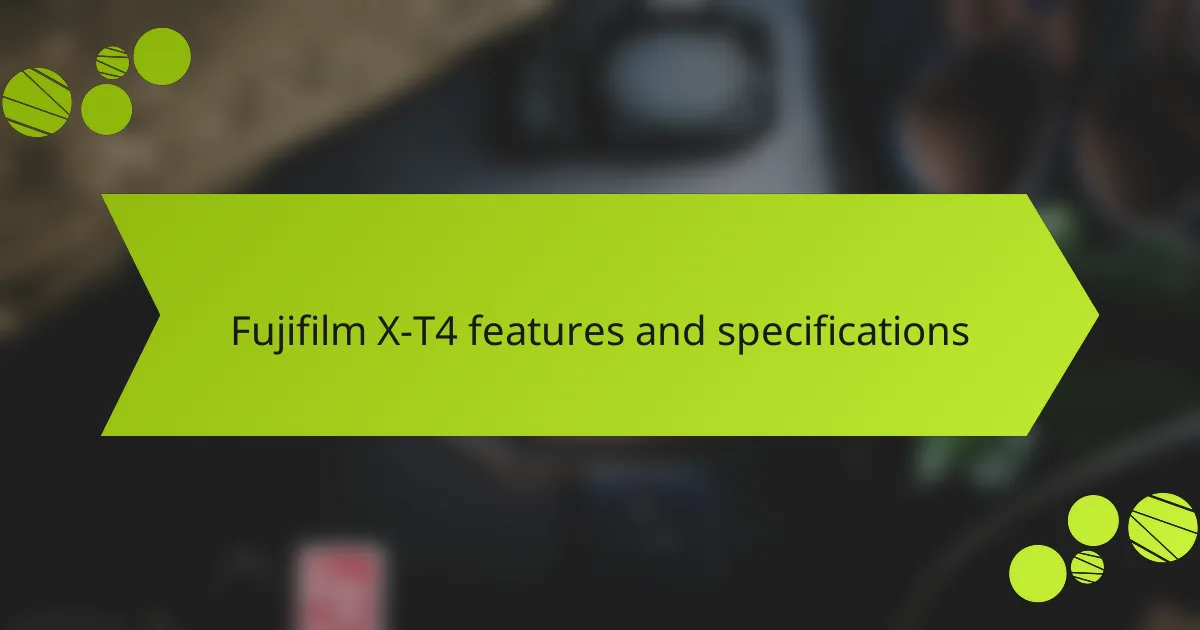
Fujifilm X-T4 features and specifications
When I first started using the Fujifilm X-T4, I was immediately impressed by its compact design and retro aesthetic, which really spoke to my love for classic cameras. The camera feels solid in hand, and it made me excited to head out on shoots. It’s equipped with a 26.1MP APS-C sensor, which delivers stunning images with rich colors and impressive detail.
One feature that stood out to me was its in-body image stabilization (IBIS), allowing me to capture sharp shots even in low light. I remember shooting a sunset, marveling at how the X-T4 kept my photos steady while my hands were slightly shaky from holding back excitement. The dual card slots also make a world of difference, giving me peace of mind knowing I won’t lose a single moment.
- 26.1MP APS-C X-Trans CMOS 4 sensor
- 5-axis in-body image stabilization
- 4K/60p video recording
- Dual memory card slots (SD UHS-II)
- Vari-angle touchscreen LCD
- Multiple film simulation modes
- Weather-sealed body for durability
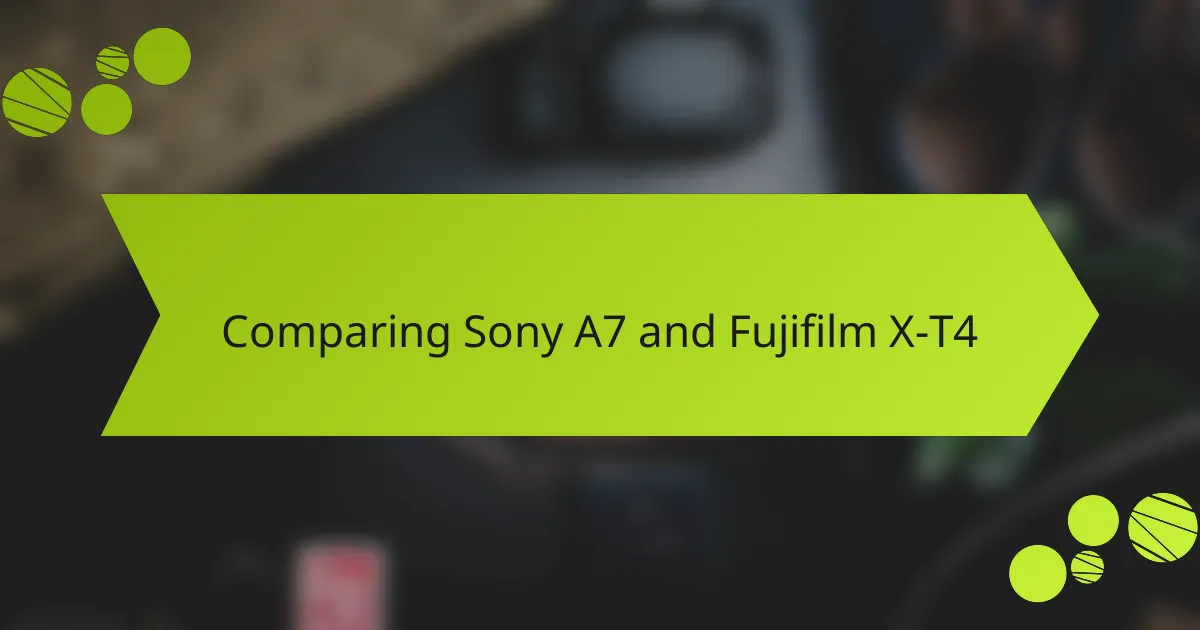
Comparing Sony A7 and Fujifilm X-T4
When I compare the Sony A7 and the Fujifilm X-T4, I notice distinct differences that reflect my photographing style. The A7 is all about that high-resolution full-frame sensor, which offers stunning image quality in low-light conditions. On the other hand, the X-T4, with its size and robust build, feels like an extension of my hand, and the film simulation modes can bring so much character to my shots.
In practical terms, the autofocus on the A7 was a game-changer during a recent event I shot; it locked onto faces quickly, delivering sharp images. Conversely, while using the X-T4, I loved how the in-body image stabilization kept things steady, allowing me to capture smooth video during a dynamic dance performance without needing extra equipment. Both cameras have their strengths, but which one suits you depends on your shooting style and what you prioritize in a camera.
| Feature | Sony A7 | Fujifilm X-T4 |
|---|---|---|
| Sensor Type | Full-frame | APS-C |
| ISO Range | 100-25600 | 160-12800 |
| Autofocus Points | 117 phase-detection | 425 contrast-detection |
| Weight | 650g | 607g |
| Video Recording | 4K at 30fps | 4K at 60fps |
| Image Stabilization | None | In-body |
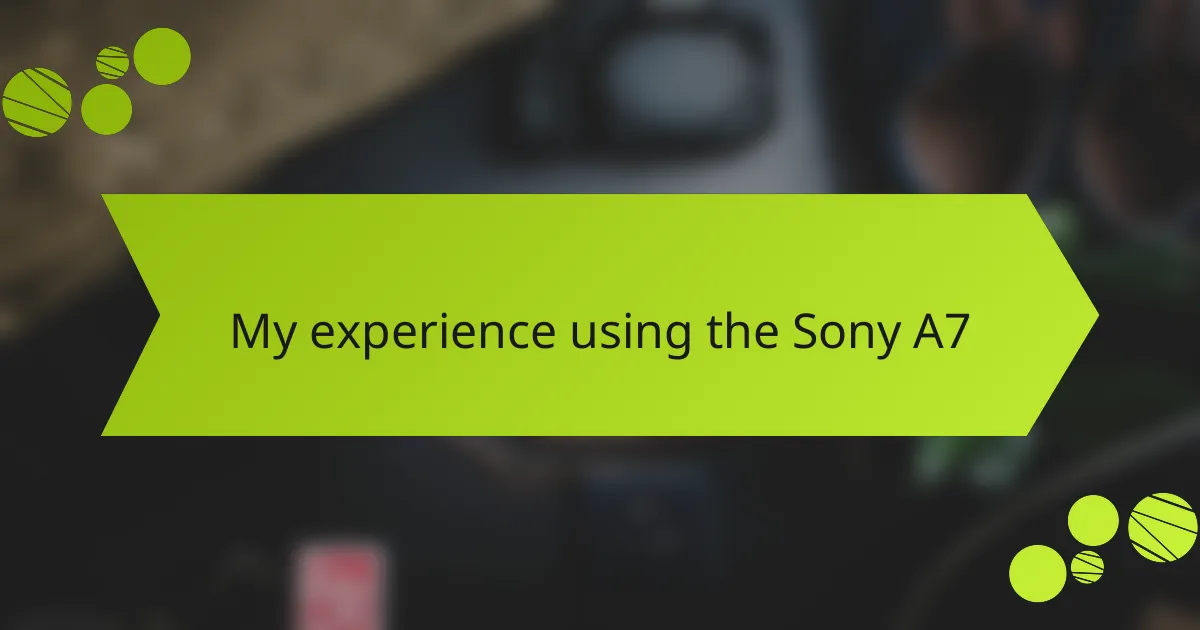
My experience using the Sony A7
My experience using the Sony A7 was quite remarkable. I remember the first time I picked it up, the weight felt just right, and I could tell it was built for precise photography. The low-light performance captured stunning details in dimly lit settings, something I truly appreciated during my night city shoots.
The autofocus system was another standout feature for me. It was fast and accurate, which made capturing moving subjects a breeze. I recall a moment when I was photographing a street performer, and the camera’s ability to lock onto the subject in a bustling environment was impressive.
| Feature | Sony A7 |
|---|---|
| Sensor Type | Full-frame |
| ISO Range | 100-25600 |
| Autofocus Points | 117 phase-detection, 25 contrast-detection |
| Video Capability | 1080p at 60fps |
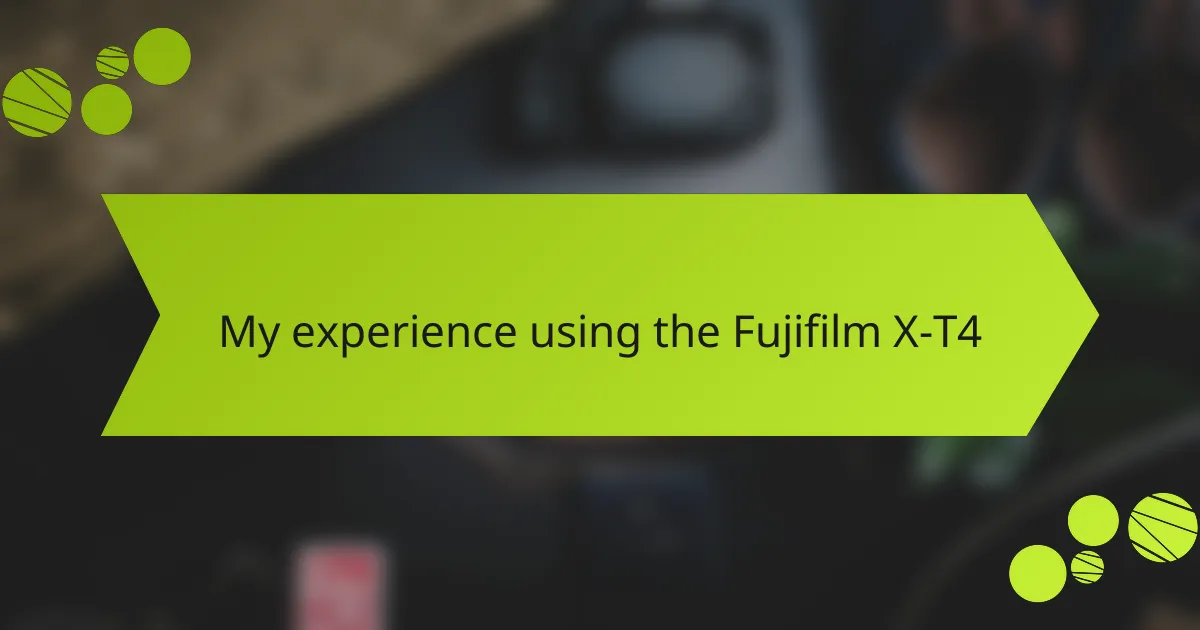
My experience using the Fujifilm X-T4
Using the Fujifilm X-T4 has been an enlightening adventure for me. I appreciate its intuitive controls and retro aesthetic, which give me a sense of connection to the art of photography. I remember my first time shooting with it at a local festival; the vibrant colors and superb autofocus allowed me to capture candid moments effortlessly.
The camera’s film simulation modes are a particularly delightful feature. I often find myself toggling between Classic Chrome and Acros, depending on my mood and the scene before me. It’s like having a digital playground where I can experiment with different looks without needing to spend time in post-processing.
Here’s a quick rundown of what I love about the Fujifilm X-T4:
- Ergonomic design: Feels great in my hands during long shoots.
- Exceptional autofocus: Reliable and fast, perfect for capturing fleeting moments.
- In-body image stabilization: Helps me shoot in low-light conditions without a tripod.
- Film simulation modes: Offers a variety of looks, enhancing my creative expression.
- Battery life: Surprisingly robust, allowing me to shoot for hours without worry.
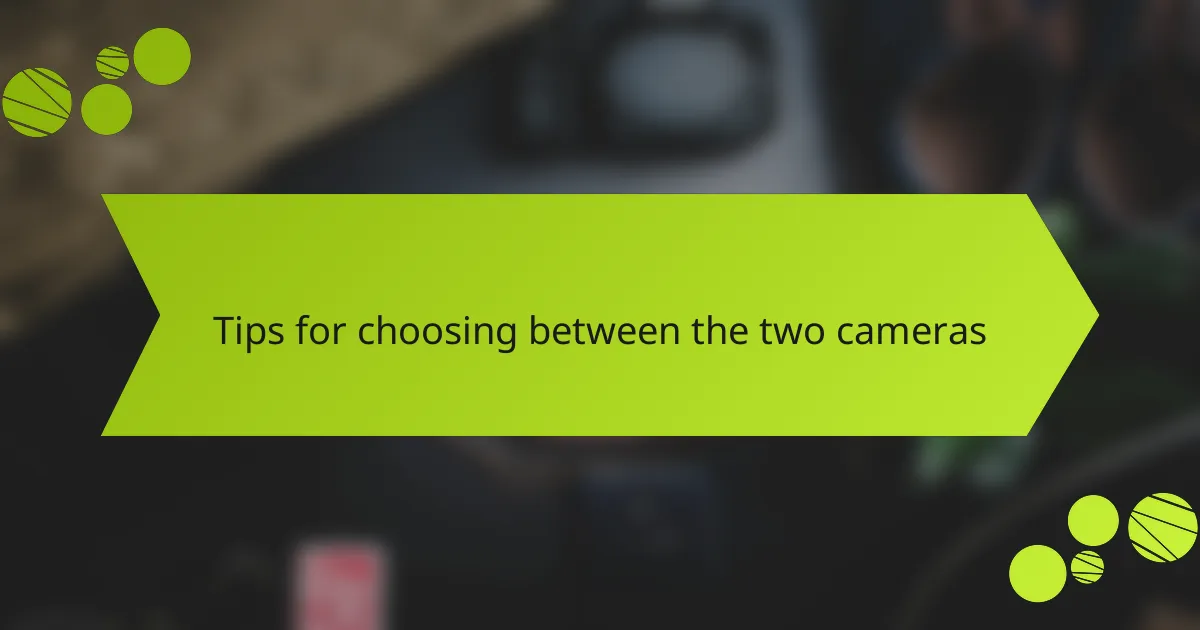
Tips for choosing between the two cameras
When choosing between the Sony A7 and the Fujifilm X-T4, it really boils down to your shooting style and priorities. If low-light performance is your main concern, you might gravitate toward the A7’s full-frame sensor. I remember capturing a breathtaking twilight scene with the A7; the details popped like magic. On the other hand, if vibrant colors and unique film simulations intrigue you, the X-T4 could be your perfect match. During a vivid autumn portrait session, it felt like I was painting with light.
Another factor to consider is the ergonomics of both cameras. The lightweight design of the X-T4 always feels comfortable in my hands, allowing for longer shoots without fatigue. But I’ve also appreciated the A7 for its solid build and balance, especially while capturing dynamic events. Think about the types of shoots you do most: would you prefer the intricate controls and aesthetics of the X-T4 or the robust precision of the A7?
Finally, don’t forget about video capabilities. While the A7 offers excellent video performance, the X-T4’s 4K at 60fps has a certain appeal for those looking to create video content. I distinctly remember a dance performance where the stabilization feature on the X-T4 made all the difference in capturing smooth, flowing movements. What aspect resonates more with you: stills or motion? This could be a deciding factor.
